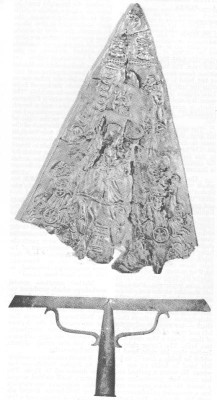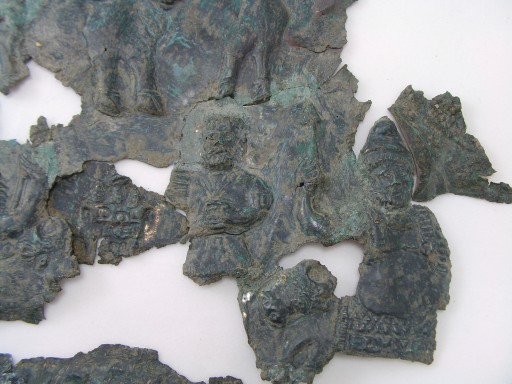| Material
|
Bronze/Copper Alloy |
|
Dimensions |
29cm
long x 23cm wide (base) |
|
Roman Empire |
3rdCentury
AD to 4th Century
AD |
|
Description |
|
Fragmented remains of a
large Jupiter Dolichenus Bronze Plaque or Standard in the shape of a triangle. The
fragments make up an elaborate scene, depicting various military and
religious scenes. The bronze was artistically engraved with figures
and animals with unparalleled attention to detail. An amazing piece
of ancient artwork.
Description of piece from top to
bottom:
The largest figure on
the piece is believed to be Jupiter Dolichenus, bare chest with typical Roman waist
belt, as well as Caligula sandals. The arms are both missing from
the scene, however the remnants of a thunderbolt (observed on other
examples with Mithras) are visible on the right side. The figure is
standing on top of a Bull with head raised, clearly showing horns.
To the left of the bull are the remains of what might have been a serpent,
scales clearly showing. To the right of the bull is what looks like
a deer/doe with defined ears. An eagle's head and beak as well as a
Wreath being held by a hand, are part of two fragments. The eagle
fragment has a border remaining so clearly belongs near the edge.
Three figures make up
the final sculptural part of the plaque. All of these figures are in
full armor of either the officer or ancient Greek style common with the
representation of Pagan Gods.
The figure on the right
has on a Phrygian cap (Greek) and a head with hair and a full
beard/moustache. He is standing behind a bull with a decorated
blanket over its back, as well as something packed on it. The figure
has his right arm resting on a pointed spear as if on guard.
The middle figure has no
cap on, however his hair and beard are also clearly visible. This
figure's right arm and legs have been lost over the centuries, however it
is clear he was most likely placing items on the alter beside him. The armor
is clearly similar with famous statutes such as the one of Caesar
Augustus. Solid muscled cuirass with a v-neck including the detailed
shoulder ruffles and waist belt. The left arm is at a right angle
and appears to be holding the hilt of his sword, pommel clearly showing.
The figure on the left
also has on a Phrygian cap (Greek) and a head with hair and a full
beard/moustache. The armor is very similar to the figure on the
right, however this one also has shoulder ruffles. He holds a
battle axe (associated with Jupiter Dolichenus) with this right arm and what looks like a spear with his left
(although the spear point is missing from the plaque).
The bottom portion of
the plaque has a large raised inscription encompassed within four areas.
Beginning underneath the last Mithric figure on the left side, then the
bulk in a large fragment and then two smaller fragments on each side of
this larger piece.
Inscription
[I?] IV VI [.] AI CCO
FLES L SACPO
History of the Mithra
Cult
Mithra was the Lord of
Light and the God of Truth and Justice was ever opposed to the Evil One.
Hence he was the Guarantor of faith and Maintainer of the plighted word.
Thus Mithraism exacted loyalty and fidelity from its followers and imposed
upon it a code of virtue similar to what is now understood by the word
"honor". In addition to this, there was engendered an esprit de
corps and true brotherhood, which was a real binding force in such an
extensive empire. It is clear to see how this would have had
profound impact on the Roman military. A rigid structure similar to
a Soldier's life in the army and a set of virtues that all could aspire
to.
The Mithra-cult with
which the Romans came into contact was a combination of Persian beliefs
with Semitic theology, incidentally including certain elements from the
native cults of Asia Minor.
The spread of Mithraism
through the Roman Empire clearly began with the conquest of Cilicia by
Pompey in 67 B.C. Plutrach recorded that Pompey “performed strange
sacrifices on Olympus, a volcano of Lycia, and practiced occult rites
among others those of Mithra”.
By the time of Trajan
(98-117 A.D.) Rome and Parthia were facing each other across the Euphrates
and Roman legions were scattered from the Euphrates to Armenia and the
whole of Pontus and Cappadocia had come into intimate contact with the
Latin world. In their turn the Roman legions were influenced by
Parthian ideas and culture and when they were transferred from Asia Minor
to other provinces of the Roman Empire these legionnaires carried these
ideas with them to every corner of Europe. This included Britain and
Spain as well as Africa. The cult spread so fast that in 307 A.D. a
sanctuary to Mithra was solemnly dedicated on the Danube as to the
Protector of the Empire. (1)
In Anatolia, near the
small town of Doliche, a Deity was worshiped whose name was recorded by
later Roman writers as Jupiter Dolichenus. His special weapon was a
double-edged axe, an ancient symbol venerated in both Crete and in Egypt.
This Deity was worshiped within the confines of Mithra and was extremely
popular among the Legions stationed on the Roman Frontier. It was a
god associated with Iron, the soldiers metal. This god was heavily
worshiped by generals and soldiers alike. Especially
Germanic ones, who were still heavily Pagan. They built temples at
forts, and all along the frontier to worship this god, as well as other
areas. There is some indication that as part of a religious
procession these bronze "standards" were used.
There are however some
question as to the use of these plaques. A few have been found that
have inscriptions clearly identifying a Soldier or Unit within the Roman
Army (Egeta "Djerdap gorge - Danube" in a Jupiter Dolichenus
sanctuary a similar plaque and holder were found. On the holder an
inscription mentions the Centurio of the I Cretan Cohors). This may
very well be the result of specific units using these "Religious" plaques
as part of their beliefs or an alternative theory begs to be posed.
Egeta Example (with
holder)

This theory ponders
whether these plaques were used as a Military Standard that was carried
into battle. It was common to display symbols of cult/religious
icons on the individual Cohor and/or Legionary Standard (1st to 2nd
Century). It is clear that these plaques were mounted on a wooden
pole as numerous finds indicate (another one found with its mounting pole
is housed at the Kunsthistorisches Museum, Vienna). (3)(2)

Could these plaques have
been used in battle or simply in a Religious procession? Many of the
plaques have inscription that appear to be Votive in nature indicating
that they were used as a personal offering as one from Hungary shows "
Iovi Dolcheno P. Ael(ius) Lucilius c(enturio) coh(ortis) I Alp(inorum)
eq(uitatae). " (4)
It is however unusual
that such an expense would have been incurred by an individual solder
simply to have a "Votive Plaque". This plaque was designed to be
mounted on a pole to carry and use, and would not have just sat mounted to
a wall. Unless these soldiers were active to a large extent in
Religious processions in which they utilized their own personalized
plaques, they would most likely would have been used for other reasons.
One possibility is they used these as a Standard in Battle.
Click on
Pictures for higher resolution

Close up view of area,
bottom right.
|

Close up view of area,
middle.
|
| 